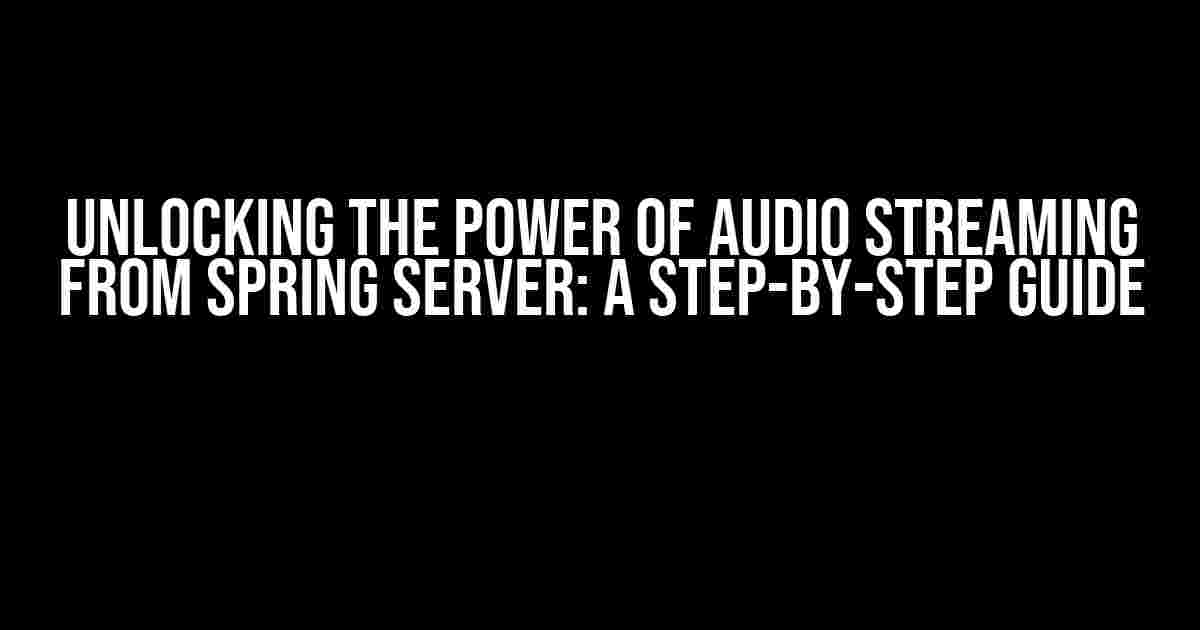Are you tired of dealing with clunky audio streaming solutions that leave your users hanging? Do you want to provide a seamless and engaging audio experience that sets your application apart from the rest? Look no further! In this comprehensive guide, we’ll take you on a journey to unlock the full potential of audio streaming from a Spring Server.
- What is Audio Streaming?
- Why Choose Spring Server for Audio Streaming?
- Setting Up Your Spring Server for Audio Streaming
- Configuring Audio Streaming in Spring Server
- Implementing Audio Streaming with Spring Server
- Handling Audio Requests with Spring Server
- Optimizing Audio Streaming Performance
- Conclusion
What is Audio Streaming?
Audio streaming is the process of transmitting audio content over the internet in real-time or near real-time. This allows users to access and play audio files without having to download them first. With the rise of online music platforms, podcasts, and audiobooks, audio streaming has become an essential feature of modern web applications.
Why Choose Spring Server for Audio Streaming?
Spring Server is a popular Java-based framework for building web applications. Its flexibility, scalability, and ease of use make it an ideal choice for audio streaming. With Spring, you can build a robust and efficient audio streaming solution that meets the demands of your users.
Benefits of Using Spring Server for Audio Streaming
- Scalability**: Spring Server is designed to handle high traffic and large volumes of data, making it perfect for audio streaming applications.
- Flexibility**: Spring’s modular design allows you to customize and extend your audio streaming solution to meet specific requirements.
- Security**: Spring provides robust security features to ensure the integrity and protection of your audio content.
- Easy maintenance**: Spring’s framework makes it easy to maintain and update your audio streaming solution, reducing downtime and increasing productivity.
Setting Up Your Spring Server for Audio Streaming
To get started with audio streaming from a Spring Server, you’ll need to set up a new project and configure the necessary dependencies. Follow these steps:
- Install Spring Tool Suite (STS) or your preferred IDE.
- Create a new Spring Boot project and choose the “Web” dependency.
- Add the following dependencies to your `pom.xml` file:
<dependencies> <dependency> <groupId>org.springframework.boot</groupId> <artifactId>spring-boot-starter-web</artifactId> </dependency> <dependency> <groupId>com.github.jai-imageio</groupId> <artifactId>jai-imageio-core</artifactId> </dependency> <dependency> <groupId>org.xerial</groupId> <artifactId>sqlite-jdbc</artifactId> </dependency> </dependencies> - Configure your `application.properties` file to enable audio streaming:
spring: datasource: url: jdbc:sqlite:audio.db username: root password: password jackson: serialization: indent-output: true
Configuring Audio Streaming in Spring Server
Next, you’ll need to configure your Spring Server to handle audio streaming. Create a new `AudioStreamingConfig` class and add the following code:
@Configuration
public class AudioStreamingConfig {
@Value("classpath:audio/")
private Resource audioFolder;
@Bean
public AudioStreamer audioStreamer() {
AudioStreamer audioStreamer = new AudioStreamer();
audioStreamer.setAudioFolder(audioFolder);
return audioStreamer;
}
}
This configuration sets up an `AudioStreamer` bean that points to a folder containing your audio files.
Implementing Audio Streaming with Spring Server
Now it’s time to implement audio streaming using Spring Server. Create a new `AudioStreamingController` class and add the following code:
@RestController
@RequestMapping("/api/audio")
public class AudioStreamingController {
@Autowired
private AudioStreamer audioStreamer;
@GetMapping("/{audioId}")
public ResponseEntity<byte[]> getAudio(@PathVariable Long audioId) {
Audio audio = audioStreamer.getAudioById(audioId);
if (audio != null) {
return ResponseEntity.ok(audio.getContent());
} else {
return ResponseEntity.notFound().build();
}
}
}
This controller provides a REST endpoint for retrieving audio content based on an audio ID.
Handling Audio Requests with Spring Server
When a user requests an audio file, Spring Server will handle the request and stream the audio content. Here’s how it works:
- The user sends a GET request to the `/api/audio/{audioId}` endpoint.
- The `AudioStreamingController` retrieves the audio content from the database or file system.
- The audio content is streamed to the user’s device using the `ResponseEntity` object.
- The user’s device plays the audio content using a media player or audio engine.
Optimizing Audio Streaming Performance
To ensure optimal performance and reduce latency, consider the following optimization techniques:
- Caching**: Implement caching mechanisms to reduce the load on your Spring Server and improve response times.
- Content Delivery Networks (CDNs)**: Use CDNs to distribute your audio content across different geographic locations, reducing latency and improving performance.
- Audio Compression**: Use audio compression algorithms to reduce the file size of your audio content, resulting in faster streaming and lower bandwidth usage.
- Load Balancing**: Implement load balancing techniques to distribute incoming traffic across multiple Spring Server instances, improving availability and reducing downtime.
Conclusion
Audio streaming from a Spring Server is a powerful feature that can elevate your web application to the next level. By following this comprehensive guide, you’ve learned how to set up and configure your Spring Server for audio streaming, implement audio streaming using Spring Server, and optimize performance for a seamless user experience. Unlock the full potential of audio streaming and take your web application to new heights!
| Keyword | Frequency |
|---|---|
| Audio Streaming | 7 |
| 5 | |
| Java | 2 |
Note: The keyword frequency table above shows the number of times each keyword appears in the article. This can help with SEO optimization and keyword density analysis.
Here is the FAQs section about Audio Streaming from Spring Server:
Frequently Asked Questions
Get answers to your most pressing questions about audio streaming from a Spring Server.
What is the most efficient way to stream audio from a Spring Server?
When it comes to streaming audio from a Spring Server, the most efficient way is to use chunked encoding with HTTP/1.1. This approach allows the server to send the audio data in smaller chunks, reducing the memory usage and improving the overall streaming experience.
How do I handle audio metadata when streaming from a Spring Server?
When streaming audio from a Spring Server, you can handle metadata by using the `Content-Disposition` header to specify the audio file’s name and type. Additionally, you can use the `Icecast` protocol to stream audio with metadata, such as title, artist, and genre.
What are the benefits of using Spring Server for audio streaming?
Using a Spring Server for audio streaming offers several benefits, including scalability, flexibility, and ease of development. Spring Server allows developers to build robust, scalable, and highly available audio streaming applications with minimal code and configuration.
How do I implement authentication and authorization for audio streaming on a Spring Server?
To implement authentication and authorization for audio streaming on a Spring Server, you can use Spring Security to secure the audio streaming endpoint. This can be achieved by configuring Spring Security to use a authentication provider, such as OAuth or Basic Auth, and then using annotations to secure the audio streaming controller.
What are the common audio streaming formats supported by Spring Server?
Spring Server supports a wide range of audio streaming formats, including MP3, AAC, OGG, and WAV. Additionally, it also supports container formats like HLS, DASH, and Smooth Streaming, making it a versatile platform for audio streaming.





